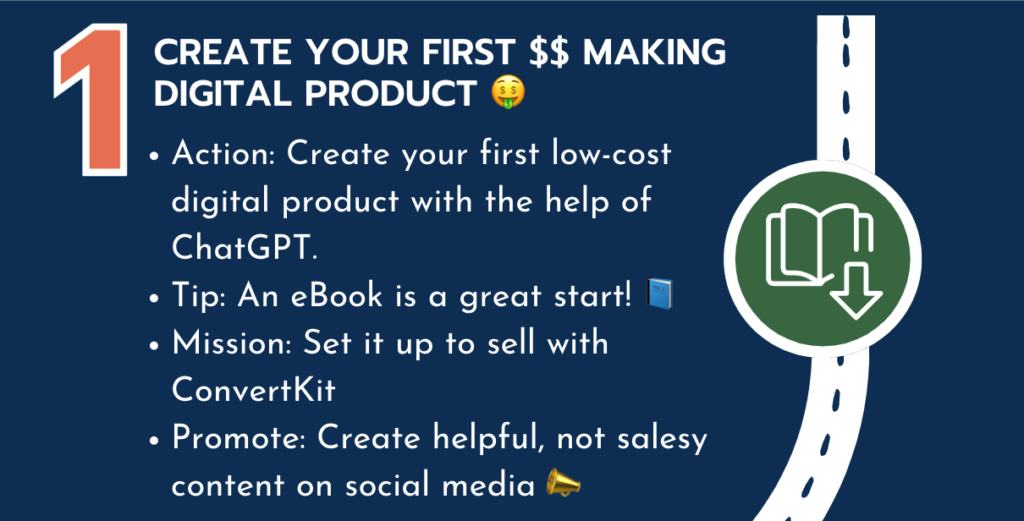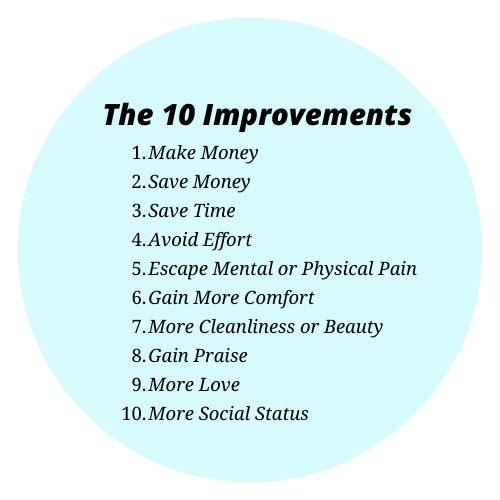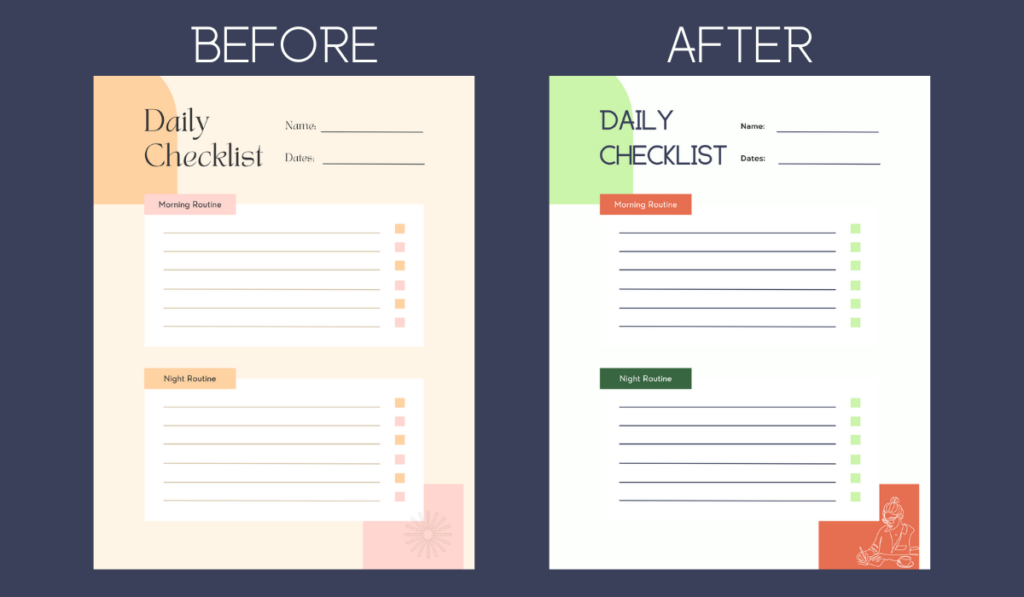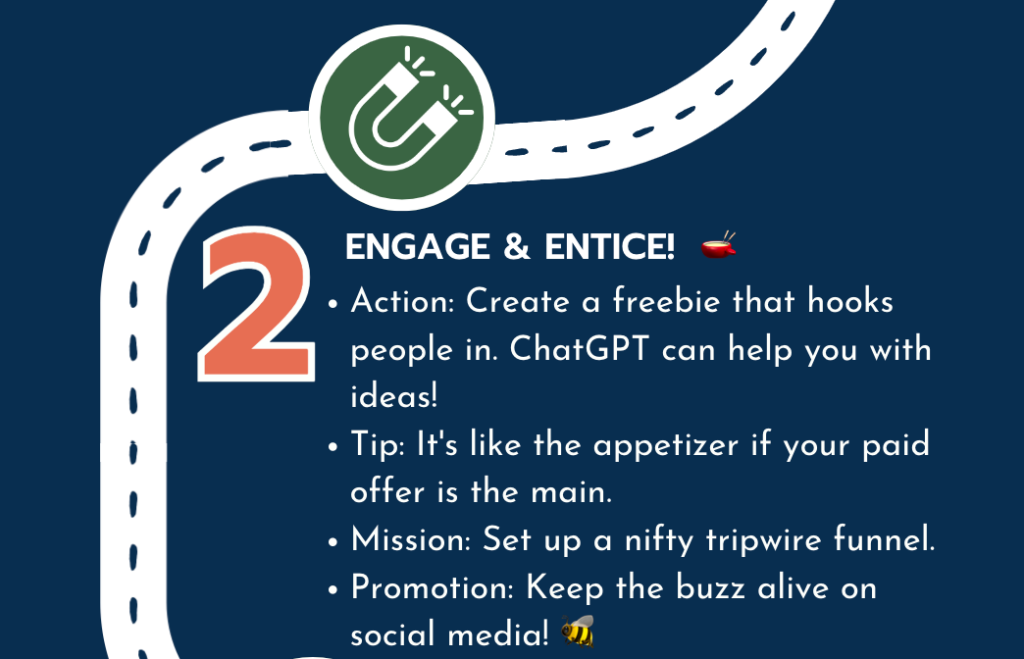“But I heard you should…”
“So and so said to do this…”
“This is the wrong way… right?!”
The problem with trying to learn how to start an online business selling products is that there are SO many people talking about how to make money online with so many different types of digital products.
It gets really, really confusing. And what’s even MORE confusing is that most of the people that you are listening to, aren’t wrong. They are just letting you know what worked for them and that’s great. But lots of things can work.
And I think that’s where all of the second-guessing of yourself begins.
And second-guessing leads to freezing. Stopped in your tracks. Not moving forward.
That’s a problem I want to help you solve.
So, I’ve taken how to make money online with digital products and broken it down into 3 phases. So that if you’re just getting started, you’ve got a simple starting place, but you can also see how that starting place can scale.
Let’s take a look.

Table of Contents
Phase 1 of How to Start an Online Business Selling Products: Creating Your First Digital Product

In Phase 1 of learning how to start an online business, you’re creating a digital product. Some people find this counterintuitive. Shouldn’t you be building an audience first? Or creating a free opt-in?
Yes, you can be working on building an audience, but it’s not important to have built one BEFORE you decide to create a digital product. And it is much easier to create your free opt-in after you’ve created your first digital product. We can talk more about that in Phase 2.
But for Phase 1, I want you to have some quick wins:
- Create a digital product that people will be willing to spend money on
- Set it up to sell
- Create content that lets people know who you help and how you can help them
This is so important in the beginning because you are going to need those wins to keep you moving forward.
When you’ve found an idea for a digital product that people will spend money on, you’ll be motivated to actually create it.
When you’ve created that digital product, you’ll see how it is going to help people and you’ll be motivated to set it up to sell.
And when you’ve set it up to sell, you’ll be motivated to make the content that let’s people know how you can help them.
Choosing the Right Product
How do you choose the right product to create? There are two answers to this question and one of them is easier than the other.
If you’re creating your first digital product as part of your journey on how to start an online business, I highly recommend making it an eBook of some kind. A how-to guide that teaches someone a skill is usually the best. If you are in a niche that is very visual, like a crafty niche, you can do a workshop, but an ebook is going to be the easiest to create and set up to sell.
That’s the easy answer.
The hard part in Phase 1 of how to start an online business is figuring out who you are going to create the digital product for (your target audience) and what problem that digital product is going to solve that they will actually spend money on.
This is where ChatGPT comes into play initially.
There are four prompts that will help you figure out who your target audience will be and what problems you can solve with all different types of digital products. These four questions will give you a starting point place for how to start an online business:
- What can you tell me about {the topic you are going to build your business around?} – This is a big, broad question and you can mostly ignore the output you get for now. Come back to it later when you need help with content ideas.
- Who is interested in learning about {the topic from question 1}?
- What roadblocks frustrate {the group of people you chose from the output from question 2} when it comes to {your topic}?
- What are the consequences that {the group of people you chose from the output from question 2} face if they cannot get past {one of the roadblocks from question 3}?
These four questions give you a starting place for the following:
- A target audience (Question 2)
- Possible topics for your eBook (Question 3)
- The pain points that are top of mind for that target audience because they can’t get past the roadblock (Question 4)
Your job is to decide which one of those groups of people would be willing to spend money on a digital product that helps them improve in your topic and which problem they would spend money on (like right now) that you can create. Then use the information from question 4 in your messaging, from your content to your sales copy.
The 10 Improvements
How do we KNOW though if someone is willing to spend money on a digital product?
This is where the 10 Improvements come in when you’re figuring out how to start an online business.
The 10 Improvements come from a book called “Copywriting Secrets” by Jim Edwards. I highly recommend reading it, but one of the most helpful parts of the book is the idea that there are 10 improvements that people are willing to spend money on.
Here they are:

These are the things that people would like to find improvement. If they are frustrated at the fact that they cannot achieve one or more of those achievements, they will spend money on a product that will help them remove roadblocks they are facing when it comes to that achievement.
For digital products, the 5 best to focus on when you’re learning how to start an online business are Make Money, Save Time, Avoid Effort, Escape Mental or Physical Pain, and More Love.
Can you make money with a digital product that focuses on or more of the other improvements when you’re exploring how to start an online business? Probably, but you’ll make your life easier if you focus on one or more of the others.
Here’s an example.
Rachel from “This Crafty Home” has a digital product (yes, it’s an eBook). It’s a guide to freezer meal planning.
It makes money. A lot of money. Multiple 5 figures a month, consistently, last time I checked in with her.
How does this $19 eBook make so much money?
Let’s look at her audience first.
Her target audience is super busy moms with little kids. If you know any super busy moms with little kids or if you’ve been a super busy mom with little kids, you know that one of the things they wake up thinking about is “I don’t have enough time to do all the things I need to do” or “I wish I had more time in my day to just have fun with my kids”.
They want more time in their day and they are frustrated because they can’t seem to get it.
Rachel’s Freezer Meal Guides teach them how to prepare a month’s worth of dinners in 4 hours that they can keep in the freezer and then throw in the instant pot at dinner time with minimal time spent.
The mom gets back a big chunk of time that she would have spent cooking dinner on a Tuesday night. Instead of chopping broccoli by the stove, she’s sitting on the couch reading books to her kids.
Rachel helps busy moms save time. That’s the primary improvement she helps with.
But you can also tie in several other improvements to her digital product.
- Save money – You’ll spend less on takeout if you have dinner prepped and ready to go.
- Avoid effort – Cooking for 4 hours on Sunday once a month means you spend a lot less effort cooking every night.
- More love – Family love in this case. Mom gets more time to make happy memories with her kids.
You could also make a case for Social Status, Gain Praise and Escape Physical Pain (since that one includes anything health related and her meals are healthy).
So when you are thinking through, “Will they spend money on this digital product?” as part of your journey on how to start an online business, those are the things you should be thinking about? Will it help them make money, save time, avoid effort, etc…
Creating the eBook
There are two things I want you to think about when you are learning how to start an online business with digital products and it comes time to think about what tools to use to create your eBook.
- What is going to be best for the content I’m about to put in this eBook?
- What is going to be the best reading experience for the person that buys my eBook?
Most of the time, the first tool that comes to mind for creating an eBook is Canva. Go find a template in Canva and fill it in with your information.
I don’t like this. I don’t think it’s best for you, your content or your reader.
I much prefer, especially for your content that is mostly text, that you create in Google docs. You can use a template (they are free). Add a nice footer, add some color in one of your headlines, but other than that, keep the template mostly as is.
Templates are specifically made to ensure that your reader is going to have a good reading experience. The fonts are easy to read. The layout has lots of white space for your eyes to rest.
Unless you have some design skills, don’t try to start from scratch. Go with something that is meant to work well for what it is.
If you have some pages that you want different layouts for, pages that aren’t all text, then go look at Canva.
Find a template that already has the elements you need.
(ps, be sure to check out our post on ebook cover design ideas where we use Canva for ebook covers!)
So for instance, let’s say you want to add a checklist to your eBook. Search “checklist” in Canva, find one that suits your needs and then change the colors and fonts to suit your brand. Here’s an example:

When you’re done, you can use a tool like smallpdf to merge all of the pages (your google docs pages and your Canva pages) into one document.
This is going to make your life easier AND it is going to make for a nice reading experience for your buyer.
Now when it comes to creating the content for that eBook, you are going to want to use ChatGPT to help you with this.
I don’t care if you know everything already about your topic.
You are at least going to ask ChatGPT to help you outline the eBook. I promise you it will think of things you didn’t, and/or it will put things in a sequence that makes sense so that you DO NOT HAVE TO THINK ABOUT THAT PART.
Ok? The more thinking we can let ChatGPT do for us, the better.
Here’s a CRISP prompt you can use to create your outline:
Context: I have an audience of people that are interested in {what you help with}. I want to create a guide that helps them with solving {the problem you’ve chosen to solve}.
Request: I would like you to create an outline for me.
Intent: The intent of the book is to help my audience {make money, save time, etc} when it comes to {the topic the eBook is covering}.
Style: I would like the style to be {choose adjectives to depict the style you want}
Parameter: Please include {something you wish to include} OR Please do not include {something you do not wish to include}.
Once you have your outline, decide what parts you want to write yourself and what parts you want help from ChatGPT on. I usually have ChatGPT help me with my introduction, conclusion and any other parts that I’m not excited to write.
When you’re done, you can also ask ChatGPT for help editing.
Once complete, create a cover page in Canva and merge all of the pages into a single pdf.
Now you’re ready to set it up to sell, which is of course an important step in how to start an online business!
Setting It Up to Sell
There are a million and one options for how to start an online business, there are about a million options for setting up an eBook to sell. So many and until you have tried a bunch, it’s hard to know how to pick one.
I’m going to make it easy for you. You’re going to set up your first eBook to sell with ConvertKit, an essential tool for this journey on learning how to start an online business with digital products.
ConvertKit is an email service provider. That means you can create a form or page to help you collect email addresses from your audience and then you can email those people that have joined your email list.
That is an essential thing that you need for your digital product business (or any online business) and you want one that is reliable and doesn’t have a gigantic learning curve.
ConvertKit ticks both of those boxes making it a suitable tool for the path to learning how to start an online business.
But that’s not all that it does. You can also set up a digital product (like the eBook you created!) to sell with it.
You’ll work from a sales page template so it is not super overwhelming to try to figure out. You’ll walk through setting up the payment processing and the delivery of the digital product, too.
So that whole part that you might have found overwhelming, is a step-by-step process in ConvertKit.
Now, the sales page that you create will work just fine for a $19-$39(ish) digital product. When you start to create more expensive products, you’ll probably want to find another way to create those sales pages. But when you’re just getting started, this is perfect.
If you aren’t comfortable with copywriting, you can ask ChatGPT for help.
The most important part of the page is going to be the headline that use.
Here’s a CRISP prompt example you can use to help you get a headline that converts:
Context: I’ve created a {guide to creating a money making online business with digital products and chatGPT}. It is meant for my audience of people that {are building online businesses with digital products like eBooks}. The product {walks you through the 3 Phases of your digital product business including creating and marketing your first product, creating an opt in and setting up a tripwire funnel and then creating another digital product to sell through an email sequence}
Request: I would like some help writing the Headline for the sales page for the product.
Intent: The intent of the headline is to let the reader know that there is a solution to their problem in the product.
Style: I would like the style to be persuasive but not salesy.
Parameter: Please include the words digital products and chatgpt. Please include at least 5 options.
Once you’ve created that sales page, you’ll have a link you can put in your bio on social media for people to check out what you have to offer, another step forward in your how to start an online business journey.
You can continue asking ChatGPT for additional help with other elements of the sales page, too.
Once the sales page is complete, you’re going to use that page as the link in your bio and start selling.
Don’t worry, you won’t hate selling if you do it in the way we’re going to talk about next.
How to Market Your eBook Without Feeling “Salesy”
In Phase 1, you’re going to start marketing. I don’t even like using that word because I think it reminds people of selling and everyone hates selling.
At least selling in the traditional, meme-ified way of the used car salesman or infomercial hawker.
We’re not doing that, ok?
The best way to market your digital product is going to be letting the world know who you help and what you help them with and then actually helping those people with that thing.
Social media works wonderfully for this and in Phase 1, I recommend starting with something like TikTok because you are going to be able to quickly reach an audience of people that are interested in what you talk about and get very quick feedback on the content you are creating.
Now, there are two types of content you want to be creating to find that audience that is going to buy your digital product.
- Outcome content
- Roadblock content
I have a blog post about social selling that walks through this and also a playlist on my TikTok channel that will show you examples of this type of content, but the basics are:
Outcome content is basically you saying, Hey, I help people like this, get better at this. There are sounds on TikTok that makes this kind of content very easy to create and it works really well.
Outcome Content is the type of content that will get people to notice you. If they are interested in what you are helping with, they will also start to pay attention to you and probably give you a follow or save your video.
Roadblock Content is the content that gives specific tips and tricks, tutorials, and hacks. Things that solve a problem that your audience is experiencing. This is where you start to get people to trust you.
This is going to be the content that gets people to check out your profile most often. And you know what is in your profile?
The link to your digital product.
So, when you’re creating content in phase 1, your call to action is going to be one of two things.
- Follow to learn more about “your topic”
- Check my profile for my XYZ guide
And that is the end of Phase 1.
You created a digital product, you set it up to sell. And instead of thinking about why you are stuck in the 200 view club, you’re thinking about what to do to get one of those 200 people to check out the eBook you created to help them.
That is a much better problem to be solving.
(If you’re starting to feel like this is A LOT for one person to do, check out this post on ChatGPT productivity prompts when you’re done with this one!)
Phase 2 of How to Start an Online Business: Setting Up a Tripwire Funnel

You’ve got a digital product that is going to help someone improve in some way. You’ve set it up to sell. You’re creating content.
You’ve got a real live business happening.
Now it’s time to add another element to the mix. A free opt-in.
I know what you are going to ask me before you even ask it.
“How do I know it’s time to add the free opt-in to the mix?!”
You can start working on Phase 2 immediately after you’ve finished setting up your digital product to sell.
If you have a very clear idea of what you want to create for a free opt-in, then you can get busy working on that.
But first! A word of caution on free opt-ins.
Here’s how I want you to think about your opt-in.
You are a chef. You have delicious entrees for your customers. Scrumptious. Life-changing entrees.
But you also have appetizers. And you want people to LOVE the apps. You want people to tell other people about the apps.
What you DO NOT want the app to do is fill them up so that they don’t want an entree.
(You see what I did there? The app is the free opt-in and the entree is your paid product.)
So, the idea is that you create a free opt-in that is a really good bridge to your paid product. It has to have valuable information in it. But you also do not want it to take away from your paid product (and you’ll see why in the next section!).
I like things like Roadmaps, Checklists, Frameworks and Cheat Sheets as an opt-in.
Be sure to ask ChatGPT for help in creating the content for the opt-in that you choose to make. Once you have the content, you can use Google docs or find a template on Canva to finish it up.
Here’s an example of a CRISP prompt you could use for the content of your opt-in:
Context: I help struggling moms learn how to incorporate self care into their daily routines.
Request: Can you create a cheat sheet that would give helpful tips on how and when to do self care for just five minutes a day?
Intent: The intent is to simplify the process of self for busy moms.
Style: Can you write in a warm but snarky style?
Parameter: Please give at least 10 tips.
Setting Up Your Tripwire
Once you’ve created the opt-in, it’s time to create a “Tripwire”.
“Tripwire” is a jargon-ish word and I usually try to avoid those, but you may have heard it before and so I’m going to use it here.
Basically, what it means is immediately after someone signs up for your free opt-in, instead of sending them to a thank you or success page, you’re going to send them to a sales page.
It’s the same sales page that you created in Phase 1 for the digital product you created in Phase 1.
Now, the reason I love this Tripwire funnel is that if you think about the journey that your potential customer has been on, presenting them with an offer at that moment in time is very smart.
Let’s say they found you on TikTok. Whatever you did in that video they saw, it got them to notice you. The information you gave made them pay attention. So much so that they decided to go check out your profile. In your profile, they saw that you had a great free checklist that seemed like it would help them out.
You see all of those positive experiences they’ve had with you?
It’s a perfect time to present them with a lower cost ($19-$39-ish) offer that is going to help them solve a problem.
If they buy it, great.
If they don’t, that’s ok, they are still on your email list because they signed up for the free opt-in.
And that is going to be very important for Phase 3.
Technically, setting up the Tripwire is fairly simple. There is an option in ConvertKit (and most email service providers) that will let you redirect your audience to a page (that will be the sales page you created in Phase 1).
Two More Things You Need to Be Doing During Phase 2
You are going to continue to do your social media marketing, ok? That is never going to stop. It might slow down a bit as you get to know your audience and what kind of content works well for them, but social media of some kind is going to be a forever thing.
In addition to that, in Phase 2, you want to start writing a weekly newsletter or some type of consistent email content for your now-growing email list.
For some reason, people (me included) get antsy when it comes to writing emails. Why? I’m not sure and it doesn’t really matter why. What matters is you get past the antsy-ness and start emailing the people on your list.
Even if it is ONE person.
You know why?
That one person doesn’t know they are the only person on your list. And they don’t care. All they care about is that when you send them an email, there is something worth reading in it.
And plus, when you’re writing your emails, even if you have a list of 100,000 people, your goal should be to always write as if you are writing to one person.
Now, if you’re stuck thinking about what to do for content for your emails, ChatGPT can help with this. A lot.
Remember earlier in this guide when we asked ChatGPT “What can you tell me about {your niche}?”.
You probably got an output with 10-12 items pertaining to your niche in it.
That list is a treasure trove of content ideas. Pick one each week and ask ChatGPT to outline an article. And if I were you, I would choose “storytelling” for the style. ;-).
So Phase 2, start emailing your person, ok?
We’re moving on to Phase 3. Can you believe it?
Phase 3 of How to Start an Online Business: Scaling Your Digital Product Business

My crystal ball tells me that you are again going to want to know, “But when EXACTLY do I start Phase 3?”
And it’s not quite an exact science when it comes to Phase 3. You might start right away after you’ve finished up your Tripwire funnel in Phase 2.
Or, you might take your time.
If you are working on building an audience, I would suggest taking your time with Phase 3. Get to know the things that your audience is stuck on. Interact with them. Learn how they talk about their problems. Build lots and lots of trust with them.
Because people buy digital products from people that they trust.
This means continuing your social media presence, (consistently!) is going to be very important during Phase 3.
Start Creating Another Digital Product
In Phase 3, the big task is to start creating another digital product. Something that is a little more robust and offers a bigger/different outcome than the one you created in Phase 1.
Here are some great choices for what format that next product should be:
- A Workshop – Perfect for covering one aspect of the journey in great detail, especially if it requires video.
- A Course – Perfect for covering multiple aspects of the journey. Will generally include text, video and interactive materials like workbooks.
- A Challenge – Perfect for when you have a community of people that are stuck on one particularly frustrating part of the journey. Creates a sense of togetherness and FUN!
And you’re going to charge a little more for this offer, too. I’d suggest in the $79 – $299 range, depending on the outcome that you are offering.
The great thing about Phase 3 is that a lot of what you figured out in Phase 1 applies here.
You already know who your audience is and you’re getting to know a lot of the problems that they face. Outlining a workshop or course or challenge is going to be very similar to what you would do to outline an eBook with ChatGPT.
You can use the same CRISP prompt from the eBook outline we used earlier, but you may want to add a bit more detail.
Here’s an example of a CRISP prompt for a Challenge:
Context: I have an audience of people that are {creating and selling digital products as an online business}. I want to come up with a challenge as a digital product to offer to them.
Request: I would like you to come up with possible topics for the challenge and also an outline for the challenge.
Intent: The intent of the challenge would be to get my audience past one particularly troubling roadblock, {writing an email series for their higher-priced digital product}.
Style: The style of the challenge should be {fun, competitive and educational}
Parameters: Please include a day for brainstorming, a day for writing, a day for setting up the technical parts and anything else that you feel would be helpful. I would also like to include a points system for getting things done and a punch list to check off when completing individual tasks.
Adding those additional parameters will help you get a much more personalized and unique output.
Now it’s on to marketing the product that you create.
Creating an Email Series for the Next Digital Product
When your offers start to get a little more expensive, you need to sell them a little differently.
Asking someone to buy a $200 course directly from social media is usually not the best practice. And that’s where your email list comes into play.
With this more expensive offer, you’re going to sell it through an email sales sequence.
That means a couple of things for you.
You’re going to have to create an email series. This is another reason why it is so important that you begin sending some type of valuable content to your email list in Phase 2.
Those emails will help build up trust and you don’t really want to have the only emails your audience gets from you be sales emails. No one likes that.
Here is a formula I like to follow for my sales sequence:
- Email 1/Day 1: Talk about a problem that you know your audience is facing that your digital product will help solve.
- Email 2/Day 2: Talk about another problem that you know your audience is facing that your digital product will help solve. You can tease the offer in this email.
- Email 3/Day 3: Talk about another problem that you know your audience is facing that your digital product will help solve. Link to your sales page.
- Email 4/Day 4: Talk about another problem that you know your audience is facing that your digital product will help solve. Link to your sales page.
- Email 5/Day 5: Short email reminding people about the digital product.
- Email 6/Day 5: Final reminder email about the digital product.
You’re also going to need a sales page for this product. And with a more expensive product, especially when you start entering the 3-digit zone, you probably don’t want to use the simple sales page template with ConvertKit.
I use my WordPress site and I design the page in Elementor.
You can also try a tool like Leadpages.
Whatever you choose to use for the sales page, you can again use ChatGPT to help you structure it and create the content for it.
One More Thing to Add to the List for Phase 3
Phase 3 is a great time to start creating longer-form content.
Actually, anytime is a great time to start creating longer-form content, but if you haven’t done it by Phase 3, you should start now.
There are two platforms I recommend for longer-form content:
- A blog
- YouTube
If you can pull off both of those and be consistent, do both.
If you have to choose one for now, choose the one that makes the most sense for your niche.
So, for me, written content is great. I can easily express thoughts, ideas and value with just words. So blogging works well for this “make money” niche.
(If blogging works well for your niche, check out this post on ways to use ChatGPT prompts for blogging).
If you are doing something in a very visual niche, it’s a better idea to go with YouTube.
Creating longer-form content is also something ChatGPT can help with.
I like to use ChatGPT to take my TikToks that have performed well and transform them into longer-form content like blog posts and YouTube videos. (You can check out the process in this video).
This creates a nice ecosystem of content that I can link to and from.
The Long Game
Once you’re in Phase 3, you’re in the long game.
You’re going to consistently work on building your audience with your content. You’re going to create new offers based on your audience’s changing needs. This could be anything from new paid products to free opt-ins to just a simple free value add that you send out to your email list.
Phase 3 is where things will start to feel more passive. You’ve got a sales sequence set up so you should start to see sales coming from that as people move along through the sequence.
You’re also going to be monitoring some statistics. Keep an eye on conversion rates for your landing pages and sales pages especially. Sometimes small changes to those pages will help you make even more sales.
Now You Know the Steps to How to Start an Online Business with Digital Products and ChatGPT
This guide was meant to take the overwhelming prospect of building your online business and break it down into smaller-sized chunks so that you can see a path to start making money NOW while also understanding the bigger picture with a structured way to scale your business.
The outline is here for you. If you’re the type of person that can take the outline and run with it, then have at it. Get started and don’t look back (except to come tell me when you’ve had a win!).
If you are the person that wants some step-by-step help for the nitty gritty tasks that are involved in Phase 1, then check out The $0-$1k Blueprint and get all of the steps and ChatGPT prompts for:
- Finding your target audience
- Discovering ideas for digital products that your audience will spend money on
- Creating an eBook
- Setting it up to sell
It’s everything you need to get through Phase 1 and start working on that first $1,000.
